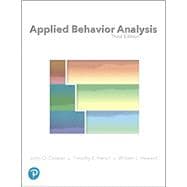A comprehensive, contemporary, in-depth discussion of applied behavior analysis principles and procedures
First published in 1987, Applied Behavior Analysis remains the top-choice primary text for appropriate courses at universities in the United States and abroad with leading programs in behavior analysis. This comprehensive text – best-suited for all upper-level courses in basic principles, applications, and behavioral research methods – helps students, educators, and practitioners appreciate and begin to acquire the conceptual and technical skills necessary to foster socially adaptive behavior in diverse individuals.
The authors' goal in revising this best-selling text was to introduce students to ABA in a complete, technically accurate, and contemporary manner. Readers will appreciate the great number of citations to primary-source literature, including both classic and contemporary studies; a glossary of technical terms and concepts; graphs displaying original data from peer-reviewed research, with detailed descriptions of the procedures used to collect the data represented; and chapters written by leading scholars in the field of behavior analysis.
John Cooper, Tim Heron, and Bill Heward were faculty members at The Ohio State University for a combined 90 years. Together they trained special education classroom teachers and leadership personnel guided by the philosophical, scientific, and technological principles of applied behavior analysis. The Ph.D. program in special education and applied behavior analysis that they and their colleagues developed at OSU was the first doctoral program accredited by the Association for Behavior Analysis International. John, Tim, and Bill each received the Alumni Award for Distinguished Teaching, OSU’s highest honor for teaching excellence. They are joint recipients of the Ellen P. Reese Award for Communication of Behavioral Concepts from the Cambridge Center for Behavioral Studies.
John O. Cooper, Ed.D., is Professor Emeritus in the College of Education and Human Ecology at The Ohio State University. His research and teaching interests include precision teaching, inner behavior, fluency building, and verbal behavior. He is a past president of the Standard Celeration Society, past member of the Board of Directors for the Society for the Advancement of Behavior Analysis, and Applied Representative to the Executive Council and as Chairperson, Graduate Program Accreditation Committee of the Association for Behavior Analysis International.
Timothy E. Heron, Ed.D., is Professor Emeritus in the College of Education and Human Ecology at The Ohio State University. Tim’s research interests include tutoring systems, inclusion of students with disabilities in general education classrooms, consultation, and self-correction instructional approaches. Tim is co-author of The Educational Consultant: Helping Professionals, Parents, and Students in Inclusive Classrooms, Fourth Edition (with Kathleen Harris, 2001). Since 2000, Tim has been an active Federal Aviation Administration, Gold Seal Certified Flight Instructor; has authored the text Instrument Flying: 10 Indispensable Principles to Know and Remember; and continues to apply the principles and procedures of applied behavior analysis to the next generation of aviators.
William L. Heward, Ed.D., BCBA-D, is Professor Emeritus in the College of Education and Human Ecology at The Ohio State University. Bill’s interests include “low-tech” methods for increasing the effectiveness of group instruction and promoting the generalization and maintenance of newly learned skills. He has authored or co-authored five other books, including Exceptional Children: An Introduction to Special Education, Eleventh Edition (with Sheila Alber-Morgan and Moira Konrad, 2017), and Sign Here: A Contracting Book for Children and Their Parents (with Jill C. Dardig, 2016). A Fellow and Past President of the Association for Behavior Analysis International, Bill is a recipient of the Fred S. Keller Behavioral Education Award from Division 25 of the American Psychological Association and the Distinguished Psychology Department Alumnus Award from Western Michigan University.
PART 1: INTRODUCTION AND BASIC CONCEPTS
1. Definition and Characteristics of Applied Behavior Analysis
2. Basic Concepts and Principles
PART 2: SELECTING, DEFINING, AND MEASURING BEHAVIOR 3. Selecting and Defining Target Behaviors
4. Measuring Behavior
5. Improving and Assessing the Quality of Behavioral Measurement
PART 3: EVALUATING AND ANALYZING BEHAVIOR CHANGE 6. Constructing and Interpreting Graphic Displays of Behavioral Data
7. Analyzing Behavior Change: Basic Assumptions and Strategies
8. Reversal and Multielement Designs
9. Multiple Baseline and Changing Criterion Designs
10. Planning and Evaluating Applied Behavior Analysis Research
PART 4: REINFORCEMENT 11. Positive Reinforcement
12. Negative Reinforcement
13. Schedules of Reinforcement
PART 5: PUNISHMENT 14. Positive Punishment
15. Negative Punishment
PART 6: ANTECEDENT VARIABLES 16. Motivating Operations
17. Stimulus Control
PART 7: VERBAL BEHAVIOR 18. Verbal Behavior
PART 8: DEVELOPING NEW BEHAVIOR 19. Equivalence-based Instruction
20. Engineering Emergent Learning with Nonequivalence Relations
21. Imitation, Modeling, and Observational Learning
22. Shaping
23. Chaining
PART 9: DECREASING BEHAVIOR WITH NONPUNISHMENT PROCEDURES 24. Extinction
25. Differential Reinforcement
26. Antecedent Interventions
PART 10: FUNCTIONAL ASSESSMENT 27.Functional Behavior Assessment
PART 11: SPECIAL APPLICATIONS 28. Token Economy, Group Contingencies, and Contingency Contracting
29. Self-Management
PART 12: PROMOTING GENERALIZED BEHAVIOR CHANGE 30. Generalization and Maintenance of Behavior Change
PART 13: ETHICS 31. Ethical and Professional Responsibilities of Applied Behavior Analysts

